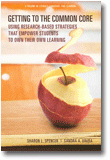
Getting to the Common Core
Using Research-based Strategies that Empower Students to Own Their Own Achievement
Edited by:
Sharon L. Spencer, North Carolina Central University
Sandra Vavra, North Carolina Central University
A volume in the series: Literacy, Language and Learning. Editor(s): Claudia Finkbeiner, Universitaet Kassel. Wen Ma, Le Moyne College.
Published 2015
The Common Core Standards have recently been adopted in most states across the nation and teachers are in the process of getting to the core of these standards. Teaching to standards is not a new concept; teachers have adapted to new standards every few years for quite some time. And teachers are adaptable, as can be seen in this book. We are writing this book to demonstrate how teachers use research-based strategies to meet Common Core Standards while still focusing on students. Our goal is to help teachers visualize students in action as other teachers describe the implementation of research-based strategies in their own classrooms, show student work samples, and provide reflections of student success in achieving the standards. Many Common Core Standards books focus on the standards, but our approach focuses on strategies that engage the students in the classroom--showing how different teachers at varying grade levels have used the strategies to meet the standards. With this focus, we believe that teachers gain a new and positive perspective on approaching the new standards and see the flexibility of strategies for meeting standards across subject areas.
We have examined research on the strategies with the purpose of giving teachers a brief description of why these strategies work before giving actual examples from classrooms. We also work closely with teachers in the public schools and have our finger on the pulse of what is happening in the public schools—one of the current stressors being unpacking the Common Core Standards
This book actually focuses on practice. We begin by laying out a rationale in our first chapter---The Core Value(s) of Education. Then, each chapter focuses on a strategy, including 1) a brief description about the research supporting each strategy and 2) several examples from different grade levels, which include a description of how the strategy was used, student work samples, and a reflection on the use of the strategy. The research descriptions are fairly short because, while we believe professional educators (aka teachers, in this case) should know the research that supports practice, we know they are not typically interested in long diatribes about the research.
CONTENTS
Foreword, Sarah Henchey. Preface. Acknowledgements. 1 The Core Value(s) of Education. 2 Learning Styles and Interest Inventories. 3 Anchor Activities. 4 Cooperative Learning. 5 Foldables, Graphic Organizers, and Mind Maps. 6 Learning Centers and Learning Stations. 7 Learning Contracts, Independent Studies, and Project-/Problem-Based Learning. 8 Literacy. 9 Mnemonics. 10 Movement. 11 Summarizing and Note-Taking. 12 Kindergarten Classroom Examples. 13 First Grade Classroom Examples. 14 Second Grade Classroom Examples. 15 Third Grade Classroom Examples. 16 Fourth Grade Classroom Examples. 17 Fifth Grade Classroom Examples. 18 Middle-Grades Language Arts and Social Studies Classroom Examples. 19 Middle Grades Mathematics Examples. About the Authors.
-
Paperback9781623969707
Web price: $62.04 (Reg. 72.99)
-
Hardcover9781623969714
Web price: $89.24 (Reg. 104.99)
- eBook9781623969721

- EDU000000 - EDUCATION: General
- EDU020000 - EDUCATION: Multicultural Education
- EDU037000 - EDUCATION: Research
-
 Authentic Voices
Culturally Responsive Teaching and Learning
Authentic Voices
Culturally Responsive Teaching and Learning
-
 Collaborative Learning in a Global World
Collaborative Learning in a Global World
-
 Educational Practices in China, Korea, and the United States
Reflections from a Study Abroad Experience
Educational Practices in China, Korea, and the United States
Reflections from a Study Abroad Experience
-
 Innovative Approaches to Teaching Multilingual Students
Innovative Approaches to Teaching Multilingual Students
-
 Listening to the Voices of Boys
Exploring the Motivation of Primary Boys to Engage in Reading
Listening to the Voices of Boys
Exploring the Motivation of Primary Boys to Engage in Reading
-
 Reconceptualizing Literacy in the New Age of Multiculturalism and Pluralism
2nd Edition
Reconceptualizing Literacy in the New Age of Multiculturalism and Pluralism
2nd Edition
-
 Views from Inside
Languages, Cultures, and Schooling for K‐12 Educators
Views from Inside
Languages, Cultures, and Schooling for K‐12 Educators

